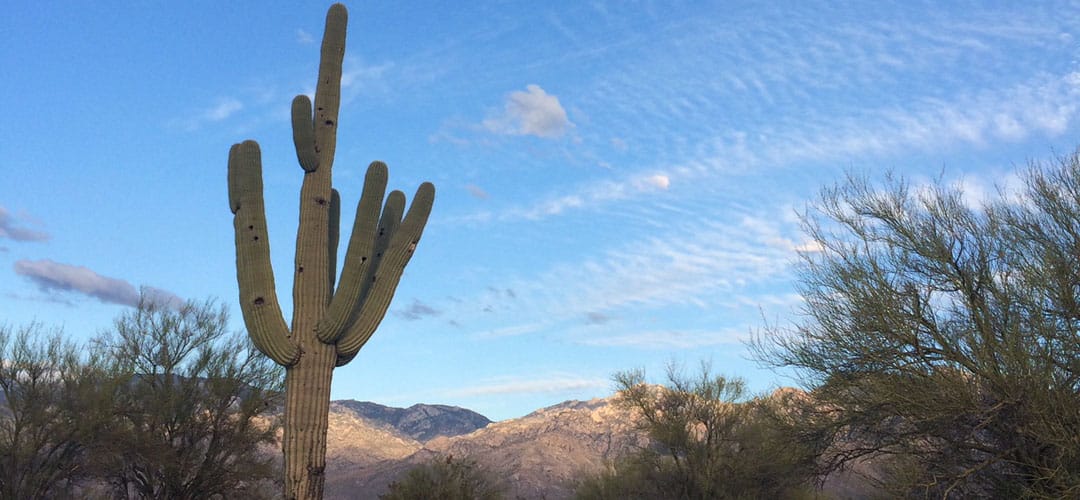
“Did you know that a saguaro once killed a man in self-defense?” I asked my family this past Christmas. None of them had heard the story, so I related the 100% true tale of how a man had been shooting at these gentle giants in the 1980s with a rifle. He shot one and it fell. He moved on to a second saguaro and shot at it enough that one of the arms fell off. In a twist of instant karma, the arm, weighing over 500 pounds, fell on the man that shot it, killing him.
While that story is a bit extreme, saguaros do seem to be one of those things that we are surrounded by but know little about. Even those of us who have learned as much as we can about them can still be flummoxed when an out-of-town visitor asks a specific fact about them. Below are some commonly asked questions about saguaros.
I planted a saguaro. How long will it take it to grow?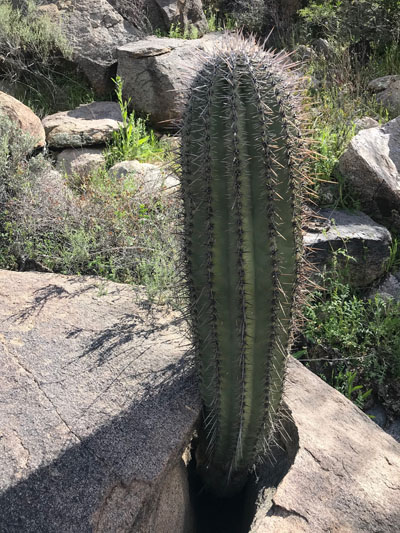
Saguaros start out incredibly small for the first few years of their life. You’ll often find them in the wild under a nurse plant such as a bush or mesquite tree, which shelters the young cactus from the elements, giving it a greater chance at survival.
How slow does it grow? Well, for the first eight years, a baby saguaro might only grow an inch to an inch and a half! So if you picked up a small one in an airport gift shop, for example, you’ll have to wait a while before you see any real progress. After the first 10 years of its life, a saguaro will grow about a foot every succeeding 10 years.
Once a saguaro is 70 years old, it will probably reach about 6 feet.
When it is around 95-100 years old, it will be around 15 feet tall. Not all saguaros grow arms, but when they do, this is around the age and height that they might start growing one. Although some start producing arms around age 70.
Saguaros can live to 200 years old and will reach their full height and can grow many arms during the last 100 years of their life. Expect one to grow around 30 to 45 feet tall – though actual heights vary by each cactus.
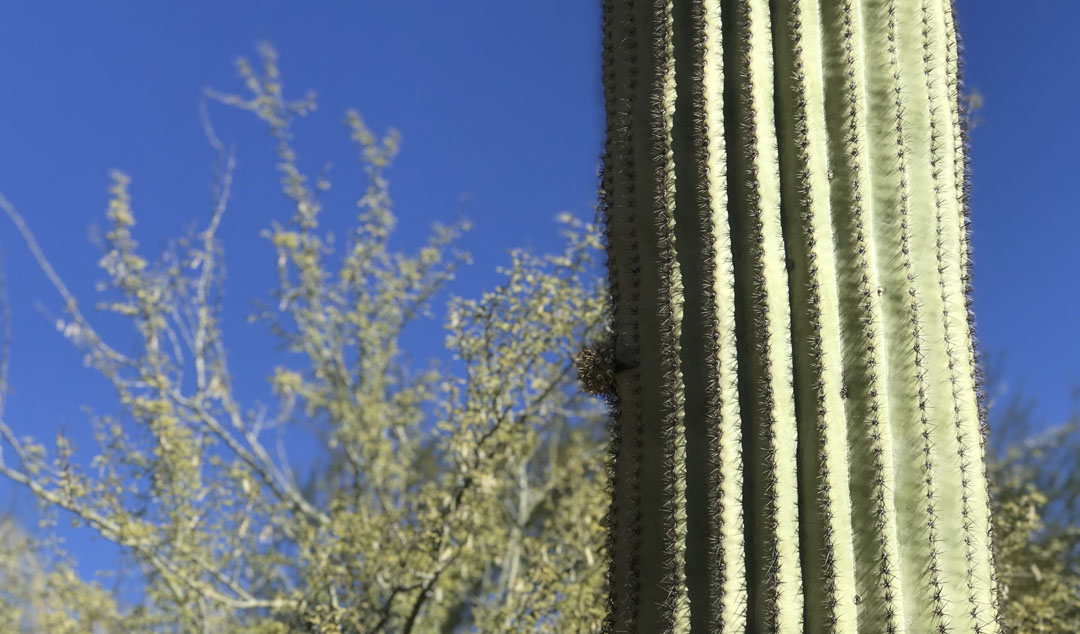
Can you spot the tiny arm beginning to grow on this saguaro?
Should I water my saguaro?
No, saguaros survive on natural rainfall alone. Saguaros have a unique root system – they have one large taproot that grows straight down 4-5 feet into the ground, accessing below-ground water, and small surface-level roots that gather rainfall. They don’t use the water immediately but instead store it for periods of drought. If saguaros are too close to an irrigation line, they have been known to rot and fall over.
When do arms appear on saguaros?
Not all saguaros grow arms, but if they do they should start appearing when the cactus is 15-16 feet tall and anywhere from 50 to 100 years old. Again, it varies on each cactus. Each arm can take 70 years to grow as well! Patience is a virtue when it comes to the mighty saguaro.
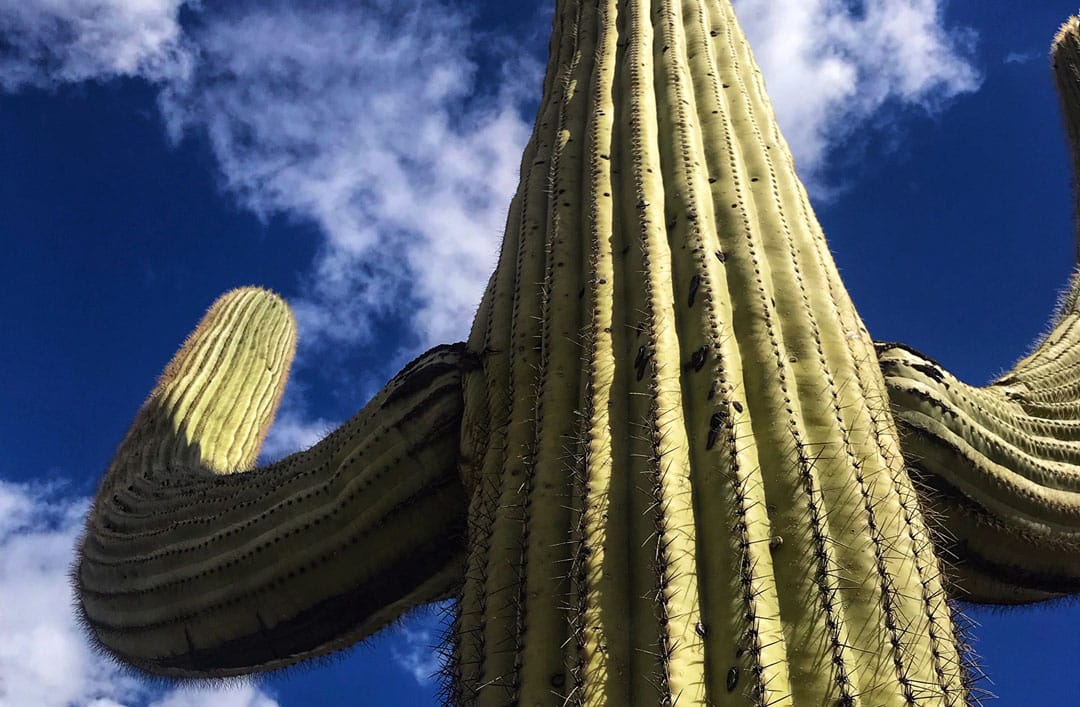
Saguaro arms take a while to grow…
What is the purpose of the ridging on the side of saguaros?
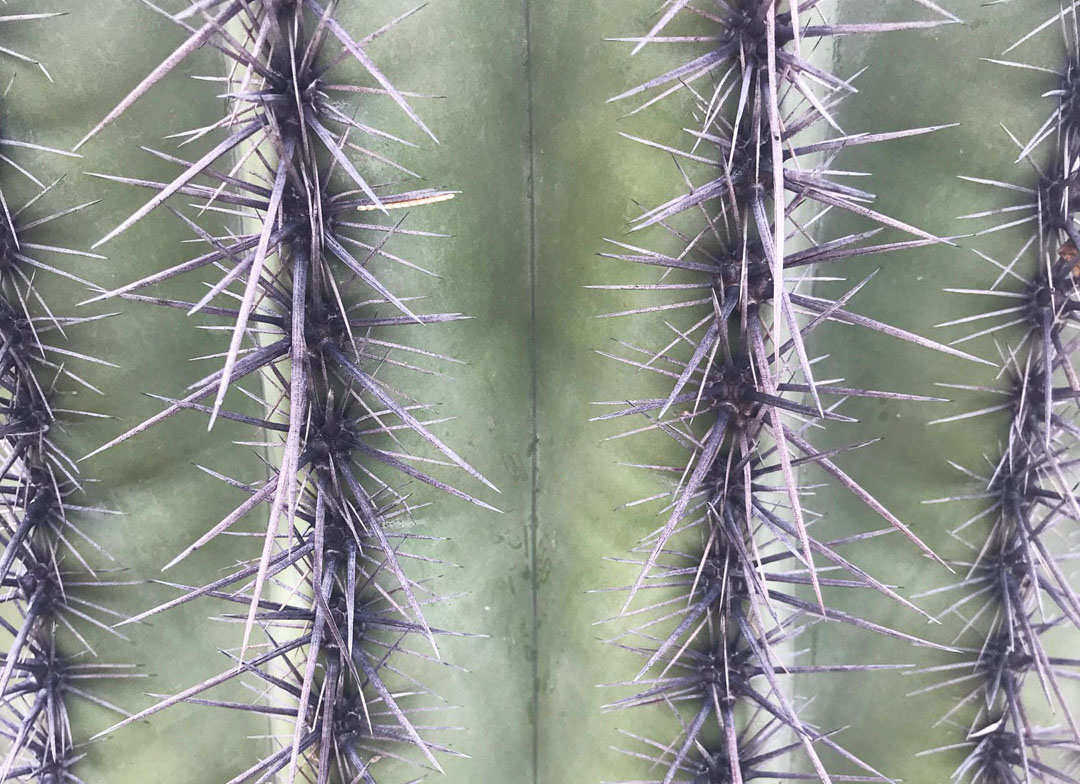
The ridges on cactus have several different purposes, and it’s kind of fascinating.
Firstly, the cactus is similar to an accordion. Saguaros store a lot of monsoon rains, causing them to expand. The ridges allow for this expansion.
Secondly, the ridges provide shade. No, really. Saguaros create their own shade using those ridges. You can notice this the most when the sun is at an angle – the ridges stand out because they create shade for the other parts of the cactus.
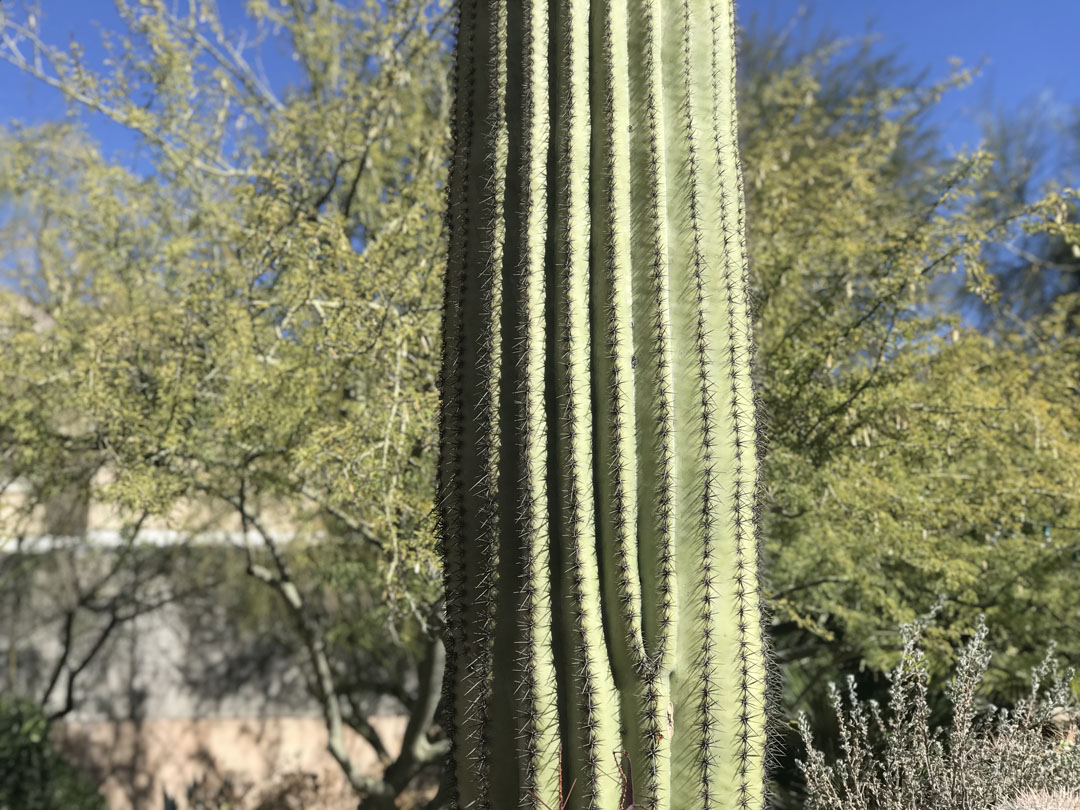
The ridges on a saguaro act as shade for the cactus, amongst other things
Finally, the ridges act as protection from wind. The way that they are shaped and placed creates sort of a wind funnel, capturing the wind and sending it back out again. This is why tall, straight saguaros in the middle of the desert are able to withstand strong winds even with their tiny root systems (note that overwatering can cause the ground around saguaros to become loose, which can lead to them falling and breaking in storms).
How long do saguaros live?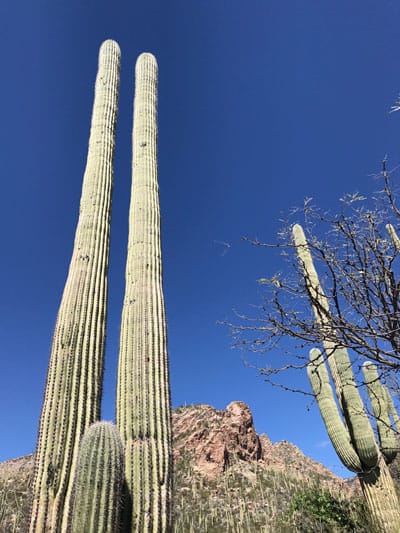
They can live for over 200 years. Next time you’re out hiking, you’ll notice that some saguaros still show gunshot holes from the early cowboy days of our area.
How tall do saguaros grow?
In general, a saguaro will grow to 30-45 feet. The tallest measured saguaro was 78 feet tall.
How much does a saguaro weigh?
One of the arms alone can weigh 500+ pounds, especially when full of water. A fully grown saguaro can weigh over a ton! When filled with water, saguaros can weigh 3,200 – 4,800 pounds!
Can I take a saguaro from a hiking trail/park/desert area and replant it at my house?
That’s a definite no. You may have heard the saying, “take nothing but photos, leave nothing but footprints,” and it’s very true about all parts of the protected saguaro. Even getting a saguaro transplant from a neighbor involves permits.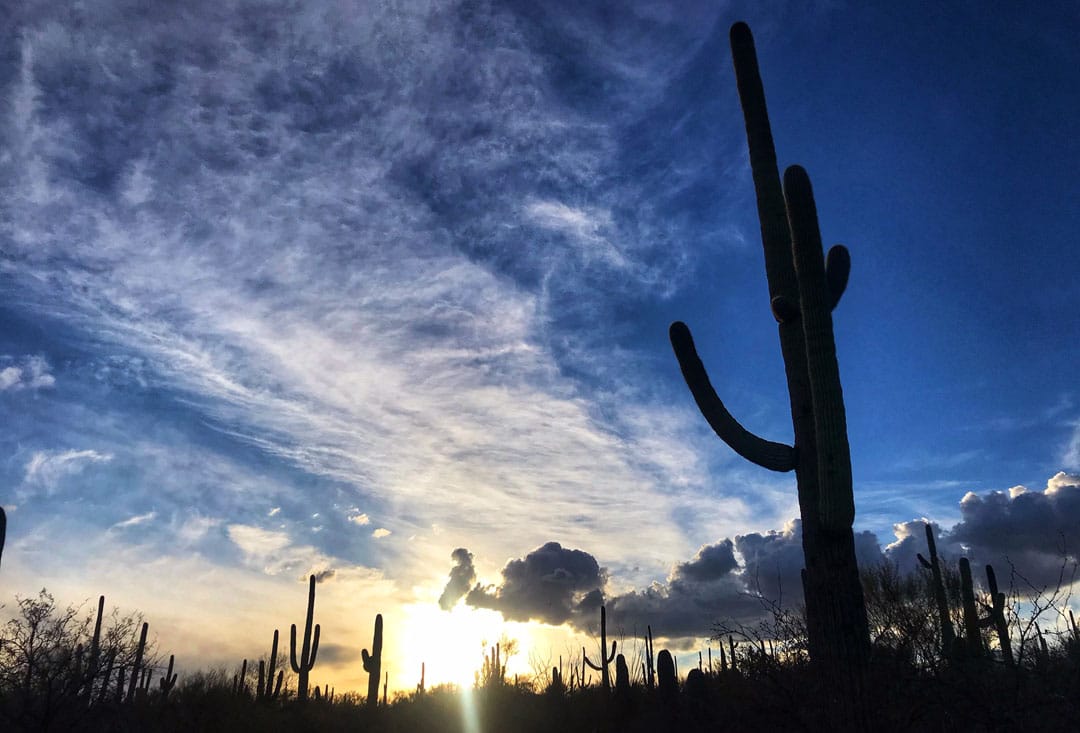
Can I take cactus spines/wood/fruits from a trail/park/desert area?
No.
What do I do if I spot holes or nests on my saguaro?
In most cases, your saguaro should be fine. Any holes below 6 feet are probably man-made, and the holes higher up on a saguaro were probably created by curved bill thrashers or Gila woodpeckers. They use the height to protect against predators and build nests inside the saguaro. Once these birds are done with them, various other birds and forms of wildlife use the abandoned “boot” that was created.
You don’t need to worry unless the hole contracts something called bacterial necrosis, which you’ll know by a black ooze that gathers or leaks from the hole. If you notice that, you may want to have it inspected by a professional.
Where’s the best place to see saguaros in the Tucson area?
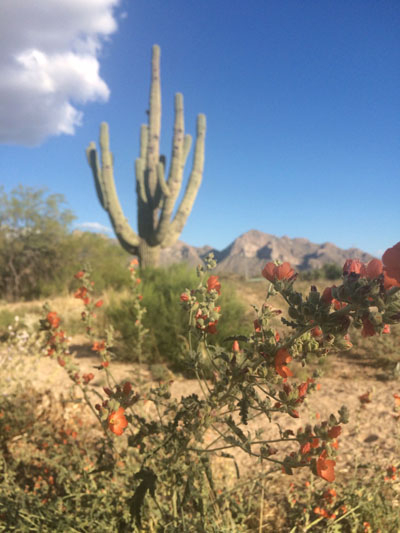
A park on the northwest side of town is dotted with saguaros. This one has since fallen.
Tucson is luckily enough to be surrounded by both parts of Saguaro National Park – the East side and the West side. It’s worth a drive through either park, a short jaunt, or a long hike. Some areas could be described as a saguaro “forest,” there are so many. It’s interesting to walk through and see all of the different shapes and sizes of saguaros.
We’re also surrounded by lots of great hiking trails! Most have saguaros dotting the area. One of my favorites is Sabino Canyon (many of the pictures in this post were taken there). Sabino Canyon has a unique crested saguaro not far from their parking lot, so you don’t have to walk far to see that unusual sight. It’s made even more unusual because there’s no agreed-upon reason why crested saguaros make their unusual fan pattern.
If you drive (or bike) up Mount Lemmon, you can spot the elevation where the saguaros stop growing and shrubs and, eventually, pine trees begin to appear. Saguaros are picky about the temperature, climate, and elevation at which they will grow. Attempts have been made to grow them elsewhere in the wild but they have been mostly unsuccessful.
The great thing about saguaros thriving here is that you can spot them all over town! In medians, in parking lots, in yards – we love our saguaro cactus!
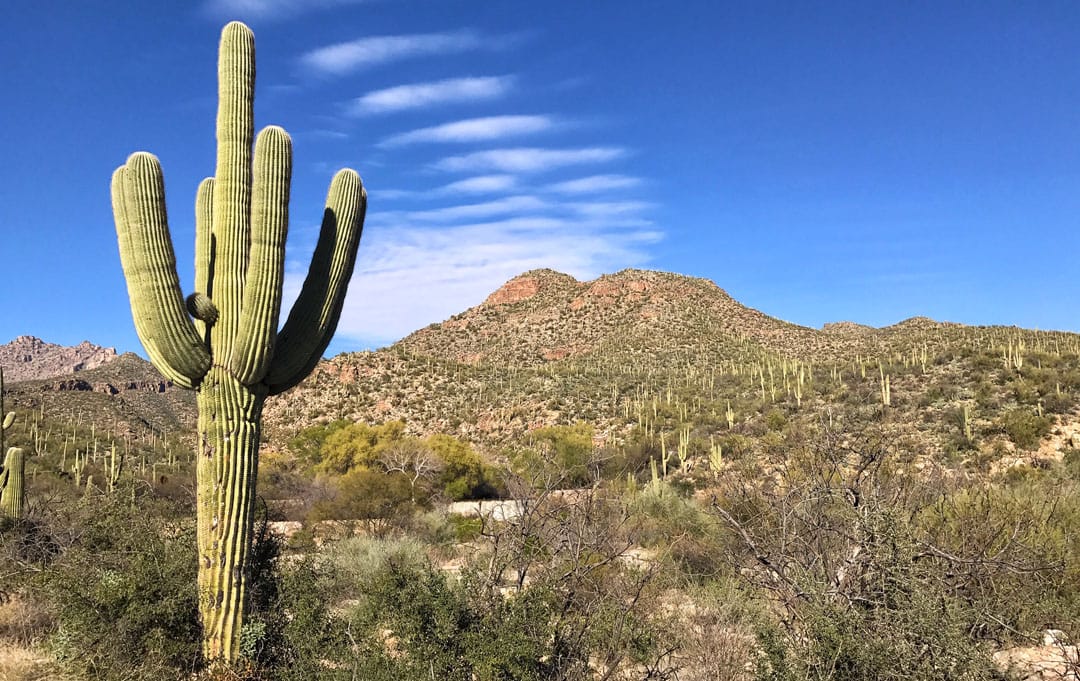
Sabino Canyon is a great place to view saguaros
Where can I buy a saguaro?
Check out our list of nurseries. Most in the Tucson area carry a variety of cacti. Because of their high value, saguaros are often stolen from abandoned properties or public lands, so be sure that any saguaro you buy has an official permit tag. Learn more about tags and permits from the Arizona Department of Agriculture here. You also want to make sure that the saguaro still has its taproot, or it will not survive.
Like other types of cacti, saguaros need to be planted in the same direction in which they were previously planted, as the south-facing side of saguaros is 15% thicker. This is usually marked before it is uprooted, so be sure to look for that. If it’s planted with the thicker side facing a different direction, the saguaro can become sunburned and damaged.
Can I move/sell/destroy a saguaro on my own property?
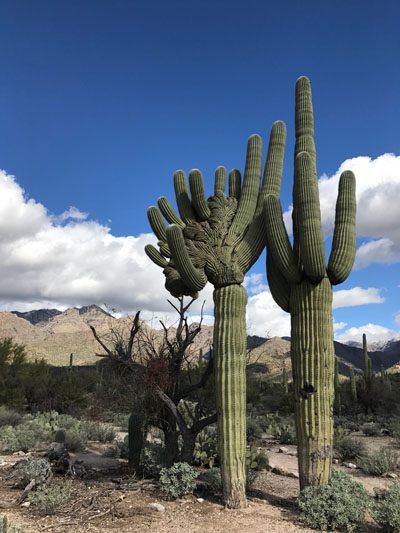
You can spot a crested saguaro not far from the parking lot at Sabino Canyon
You have the right to do so…but you must tell the department of agriculture beforehand or risk a fine or penalty. If you’re moving it off of your property, you’ll need a permit (which currently costs $7) and a tag (which will cost you $8). Saguaros can sell for around $100 a foot, but most need to be very healthy to sell to a cactus “dealer.”
What is the biggest danger to saguaros today?
Humans. Many saguaros are moved or destroyed to make room for construction and new builds. Sometimes people decide they don’t want them on their property. And saguaros in the wild are still defaced and destroyed for “fun.” As one saguaro can take over 100 years to reach maturity, efforts are being made to protect these green giants. Saguaros are strictly protected by the state, and one can be charged with a class four felony if found stealing, defacing, or destroying one.
Here in the Tucson area, buffelgrass is another threat to our native saguaros (Saguaro National Park refers to it as the “archenemy of the Sonoran Desert”). This invasive grass was brought from different areas but has taken over where native plants used to grow. Buffelgrass is known to use up the water that would normally be absorbed by saguaros, leading to their decline. It also catches fire quickly during wildfires, bringing fire to trees and saguaros. You can see evidence of this on Sentinel Peak (also known as “A” Mountain). On July 4, 2017, fireworks ignited a fire that quickly spread from the buffelgrass growing there, scorching many saguaros and killing all the palo verde trees.
Other random saguaro facts
- The scientific name of the saguaro is Canegiea gigantea, named after Andrew Carnegie.
- The Arizona state flower is the saguaro bloom. Each flower is only open for one day, so pollinators have limited time to reach the flowers (and we have limited time to view them!)
What’s your favorite thing about saguaros? Let us know in our Facebook group!